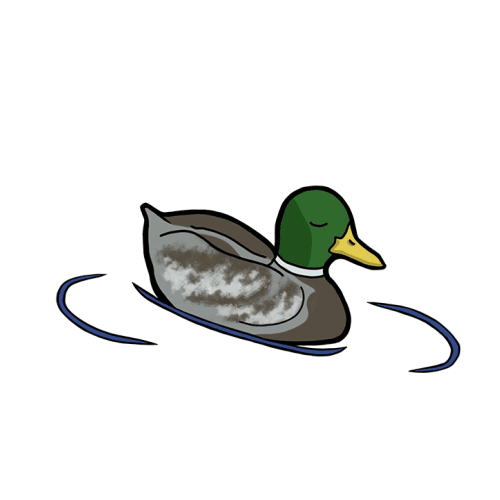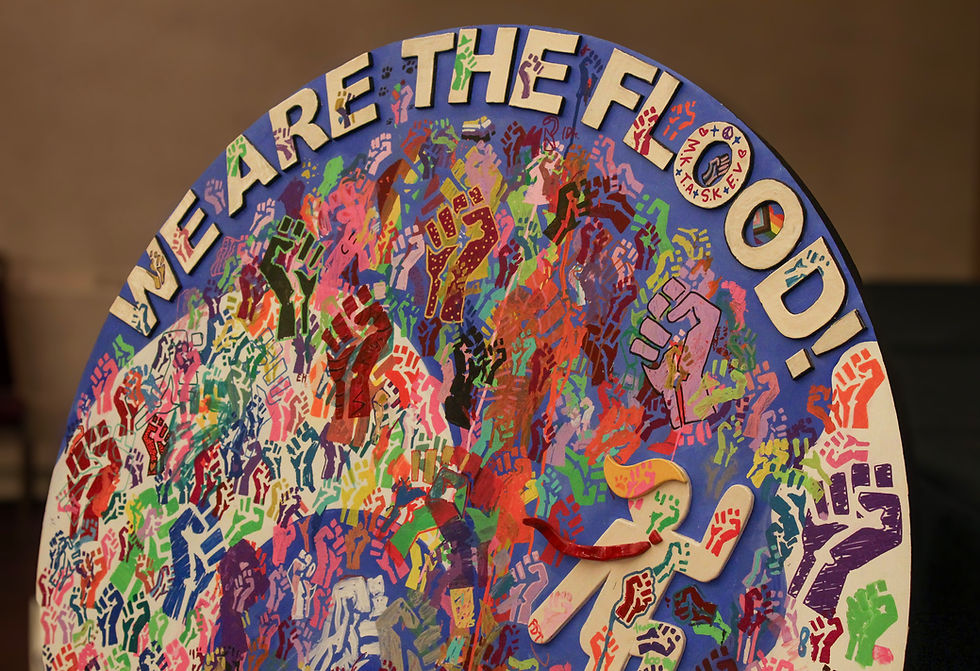Opinion: Bloom Bloom Wow: Finding hope in a climate doom comedy
- Maisy Clunies-Ross, Staff Writer
- May 22, 2025
- 4 min read
Updated: Sep 2, 2025

Even before its opening night on Friday, April 11, “Bloom Bloom Pow” had cemented its relevance in the consciousness of many Willamette students through advertisements asking for students’ trash. This gave students an opportunity to contribute to the production: to give new purpose to trash, to transform something typically discarded and disregarded. The production team utilized the garbage well, masterfully crafting old bottles, cardboard and plastic bags into an immersive and surprisingly beautiful set, as well as incorporating some garbage into the costuming. While many components of the show were unconventional, the team behind “Bloom Bloom Pow” created an engaging and thought-provoking experience for all who watched.
The show begins with nearly all of the cast members on the ground, breathing in and standing up at various intervals, seemingly to simulate photosynthesis. Then, the focus shifts to the protagonist, Mag (Grae Siebenaler-Ransom ʼ26), who is dancing with the Creature (Pollox Geissinger,ʼ28). As the two connect and the Creature mirrors Mag’s movements, the audience has time to take in the splendor of the set. It is made up of blues and greens, with green jellyfish-looking orbs in the front and large sheets of plastic like a canopy above, filtering the light so the set has an underwater appearance. In the middle, a statue-like dark figure stands completely still, framed by a plastic rib cage. The otherworldly essence of the scenery is juxtaposed with the mundane garbage from which it is made.
Then, Mag’s dance with the Creature ends, and they’re in a bar, chatting with Alice (Ainsley McClure ʼ25). Their banter is flirty, albeit awkward, perfectly capturing the nervous energy of a first date. It feels reductive and somewhat futile to express the plot of the show so simply. The play is quite long, a little over two hours and relies on metaphorical and nonlinear storytelling. The scenes shift between moments of Mag and a boy from their high school, to Mag’s museum job and eccentric coworkers, to intimate moments from Mag’s burgeoning relationship with Alice, to Mag’s intense but undefined connection with the Creature. There are snippets of anxiety-inducing calls between Mag and their mother, conversations between the Great Lakes, and disconcerting monologues from the dark figure, who is revealed to be not a statue but the unsatisfied spirit of a dead horse.
While the transitions between scenes and the connection between the characters may be initially unclear, the importance of each moment and the interconnected nature of the stories is revealed as the show goes on. Each of Mag’s scenes is grounded in their consistent emotionality. In all aspects of their life, Mag feels anxious and alienated. They’re constantly worried about climate devastation, which often makes them spacey or unable to focus on the comparatively trivial concerns of those around them. For most of the show, Mag only appears to be comforted by the presence of the Creature, a kindred spirit for whom they do not need to put on the performance of being fine. However, even this relationship falters as the Creature becomes more powerful (and more dangerous), when they grow less concerned with the human world and more in touch with the town’s algae.
The scenes are also held together by their shared theme, the way everyone’s actions contribute to climate change and how our current culture is ill-equipped to handle it. Mag and Alice fight at the museum, gazing upon an art piece that centers climate change. Alice finds the piece beautiful, commenting that there can be beauty even in these troubled times, while the piece only serves to further distress Mag. The boy from Mag’s high school, Floyd (Miles Wooster ʼ27), is a farmer dealing with financial instability as he faces criticism for the environmental impact of farming techniques. The dead horse (Olle Wurtzel ʼ25) comments on the past, the inevitability of death and all the plastic used these days. The horse laments the way people refuse to take accountability for the world’s grime. Instead, they simply opt to move it briefly out of sight, making it someone else's problem, rather than solving it. Mag’s coworkers, as socially progressive as they appear, are more focused on their own joy than the state of the world. Although the specifics of the scenes vary, their message is very clear. There is no simple solution, no easy way out. There is no end in sight.
As depressing as this may be, the play is, by its own admission, a Climate-Doom Comedy. The story seems less intent on presenting the audience with a resolution and more focused on shedding light on the way contemporary life interacts with climate change. To solve any problem, it must first be acknowledged. “Bloom Bloom Pow” takes on the task of acknowledging the problem of climate devastation. It encourages the audience to recognize their own complicity, to look in the mirror and ask themselves what they could do differently. Do not give in to wellness culture, the play chides. Do not let yourself believe that ignorance is resistance. Do not pretend your actions have no impact. Do not forget what is happening all around you.
And yet, even in its doomerist state, “Bloom Bloom Pow” offers some answers. There is some emotional catharsis at the end of the play. It feels good to just watch Mag hug their mother at the end, to see that they are not completely alone. However, this is not the only emotional release. The production itself offers the audience a path forward. The whole set is made up of trash, which has been given importance, value, and new significance through the play. It is physical tangible proof of what the creativity and resilience of the human spirit can create in the face of tragedy. The play’s message is a reminder of our cultural sickness, but the act of production is proof of our culture’s ability to heal. The production was made up of people like Mag, people who care about the climate and find the current state of the world troubling. But, unlike Mag, they weren’t so isolated. They came together, one community all working towards a common goal. They didn’t let fear paralyze them. Instead, they turned towards action.
That is the power of “Bloom Bloom Pow.”




It’s nice to see these kinds of plays being staged. ShayariHeart I hope they keep delivering inspiring and meaningful plays this year.
It is good to see such plays being presented. I hope they continue offering thought provoking plays this year